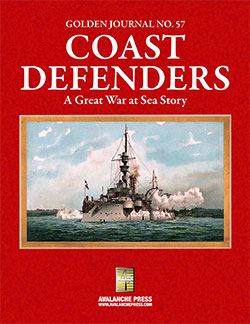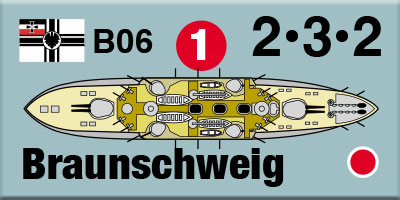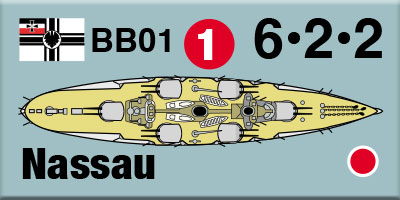| Golden Journal No. 57: Coast Defenders
The Pieces, Part One
by Mike Bennighof, Ph.D.
March 2025
 Golden Journal No. 57: Coast Defenders is an oversized edition of our intermittent publication, all about some ships from Great War at Sea: Jutland 2e that have been re-considered during the time between the game’s first edition and release of the second edition. Golden Journal No. 57: Coast Defenders is an oversized edition of our intermittent publication, all about some ships from Great War at Sea: Jutland 2e that have been re-considered during the time between the game’s first edition and release of the second edition.
All told the Journal includes 50 new die-cut and silky-smooth pieces, all sporting brand-new-artwork. They replace pieces from the Jutland game; the game plays just fine with the original pieces (a ship’s real capabilities are kept on the Ship Data Sheet), but these make it more fun to play. Let’s have a look at them.
Kaiser Friedrich III Class
Germany’s first high-seas battleships pre-dated State Secretary Alfred Tirpitz (he acquired the “von” only in 1900), and he inherited a completely inadequate design armed only with four 240mm (9.4-inch) guns instead of the 305mm (12-inch) guns that armed battleships of other nations. That decision came from a mis-understanding of the 1894 Sino-Japanese War, which seemed to indicate that a high rate of fire was more valuable in combat than a heavy shell. Not only was this not true, the new-model 240mm gun had serious flaws that robbed it of its supposed high rate of fire.

The design matched inadequate firepower with weak protection, but even so the German Navy built not only five ships in this class but another five in the succeeding Wittelsbach class. All ten of them took part in the earliest operations of the High Seas Fleet in 1914 (see our North Sea 1914 book), an insane risk of nearly 7,000 lives aboard these floating targets.
The first edition of Jutland, the game, gave these ships a nominal primary gunnery factor of 1, to avoid making them utterly useless. But they were utterly useless, and the second edition reflects this in its ship data. The new playing piece makes it clear that these ships had no place in the line of battle.
Wittelsbach Class
State Secretary Alfred von Tirpitz knew the Wittelsbach design to be hopelessly inadequate. The decision to build five of them came about through the complicated politics of the Second Reich, and the failure of the German Navy’s Construction Department to provide a better alternative (and Tirpitz to commission designs for larger guns) in a timely manner.

Tirpitz received an unexpected funding windfall in early 1898, and only a narrow window in which to spend it. So, he repeated the Kaiser Friedrich III design, with only minor improvements. These ships carried a main armament of four 240mm (9.4-inch) guns, a much smaller weapon than those of other nations. Making things worse, it had a very slow rate of fire.
Like the Kaiser Friedrich III class, these ships had a nominal primary gunnery factor of 1 in Jutland’s first edition. The second edition gave them more appropriate gunnery factors in its ship data, and the new playing piece matches this.
Braunschweig Class
The first true battleships built for the German Navy, the Braunschweig class marked the adoption of a true heavy-gun armament, though even then the 280mm (11-inch) main guns did not match the standard 305mm (12-inch) caliber of British battleships.

Five ships of the class were built between 1901 and 1905, under the famous Second Naval Law that made the eventual High Seas Fleet possible. They participated in the early operations of the High Seas Fleet in the North Sea (seen in our North Sea 1914 book), but only one of them, Hessen, took part in the Battle of Jutland.
They made between 18.2 and 18.7 knots on their trials, perfectly adequate for 1901 but no longer close to the expected fleet speed of 1916. Jutland’s first edition still gave them the standard speed value of 1, which is much too generous. The game’s second edition corrected this in the ship data, and now we have a playing piece to match.
Deutschland Class
Germany’s final pre-dreadnought class was smaller than their British contemporaries, to allow them to fit through the Kaiser Wilhelm Canal linking the North and Baltic Seas; it would later the widened to accommodate dreadnought battleships. They carried four 280mm guns in two turrets, fore and aft, and a secondary battery of fourteen 170mm guns in casemate mounts.

Five of the class would be laid down between 1903 and 1905, commissioning between 1906 and 1908, well after Dreadnought had revolutionized battleship construction. One ship, Deutschland herself, would serve as fleet flagship in the years before the Great War.
The fastest of them, Schleswig-Holstein, made 19.1 knots over the deep-water mile; Deutschland, with an older boiler arrangement, had a top speed of just 18 knots. That’s nowhere close to qualifying for the Speed 1 rating they received in Jutland’s first edition, so our spiffy new pieces show them with the 1-slow speed they have in Jutland Second Edition’s ship data.
Nassau Class
Germany’s first dreadnoughts followed an evolutionary path from the final pre-dreadnoughts of the Deutschland class through the abortive designs for a semi-dreadnought with a mixed main battery and a small dreadnought with eight 280mm guns. Those ships, which were never built, are found in our Risk Fleet book.

Nassau carried a dozen 280mm guns, compared to just four for her predecessor, Deutschland, so she marked an enormous leap forward in firepower. But she retained the triple-expansion engines of the earlier ship, as Germany could not yet produce reliable turbines like those powering Britain’s revolutionary HMS Dreadnought.
Her “hexagon” design had nothing to do with her engines, as some secondary works claim; it was the natural progression from Deutschland through the semi-dreadnought and small dreadnought designs.
Germany built four ships of the class, laying them down in 1907 and commissioning them in 1910. They participated in all of the High Seas Fleet’s major operations, and all four survived the war though one, Rheinland, was badly damaged by grounding in April 1918 and never repaired. All four were broken up after the war.
Jutland’s first edition gave the class Speed 1, which usually means a top speed of 21 knots. The fastest speed any of them recorded on trials was 20.2 knots clocked by Westfalen, and all of them struggled to reach 20 knots in service. More telling than those figures, though, is High Seas Fleet commander Reinhard Scheer’s worry over the four Nassaus being run down by the faster British battle line. That seals it, at least for this game designer. They should have a speed of 1-slow, as the new pieces (and the Jutland Second Edition ship data) show.'
And that’s what we have in Golden Journal No. 57: Coast Defenders. A set of wonderful ship pieces, and the stories of the ships they represent.
The Golden Journal is only available to the Gold Club (that’s why we call it the Golden Journal).
Click here to join the Gold Club.
See your Gold Club Insider newsletter for ordering information.
Sign up for our newsletter right here. Your info will never be sold or transferred; we'll just use it to update you on new games and new offers.
Mike Bennighof is president of Avalanche Press and holds a doctorate in history from Emory University. A Fulbright Scholar and NASA Journalist in Space finalist, he has published a great many books, games and articles on historical subjects; people are saying that some of them are actually good.
He lives in Birmingham, Alabama with his wife, three children, and new puppy. He misses his lizard-hunting Iron Dog, Leopold.
Want to keep Daily Content free of third-party ads? You can send us some love (and cash) through this link right here.
|
